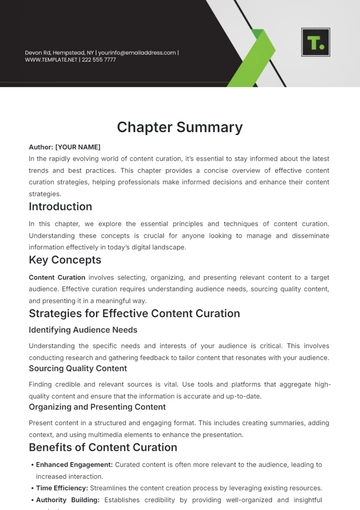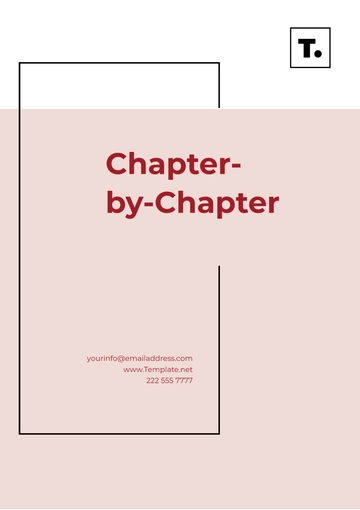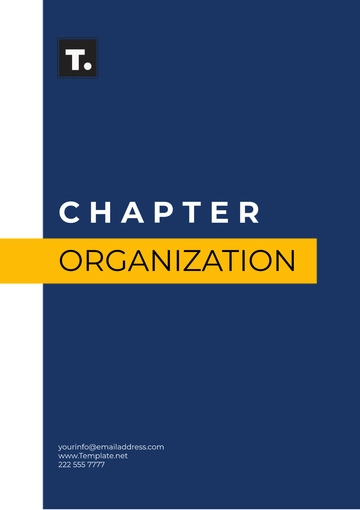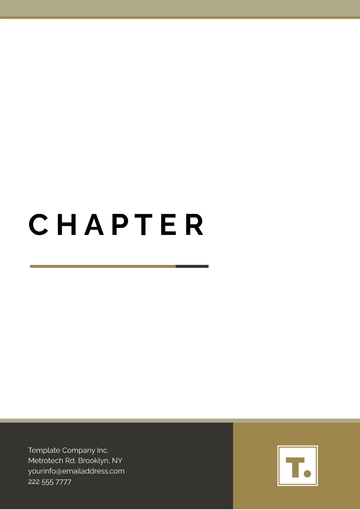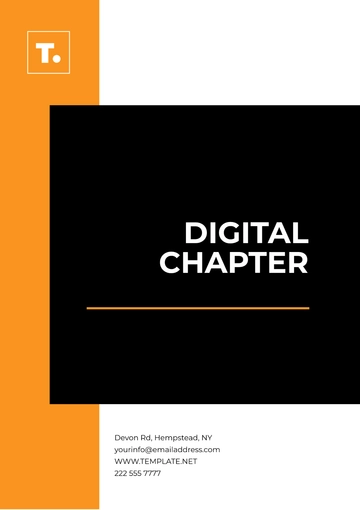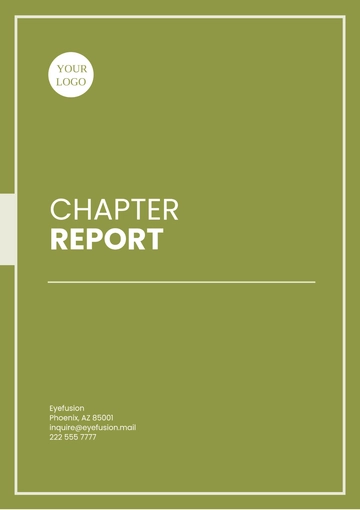Free Student Feedback Chapter Outline
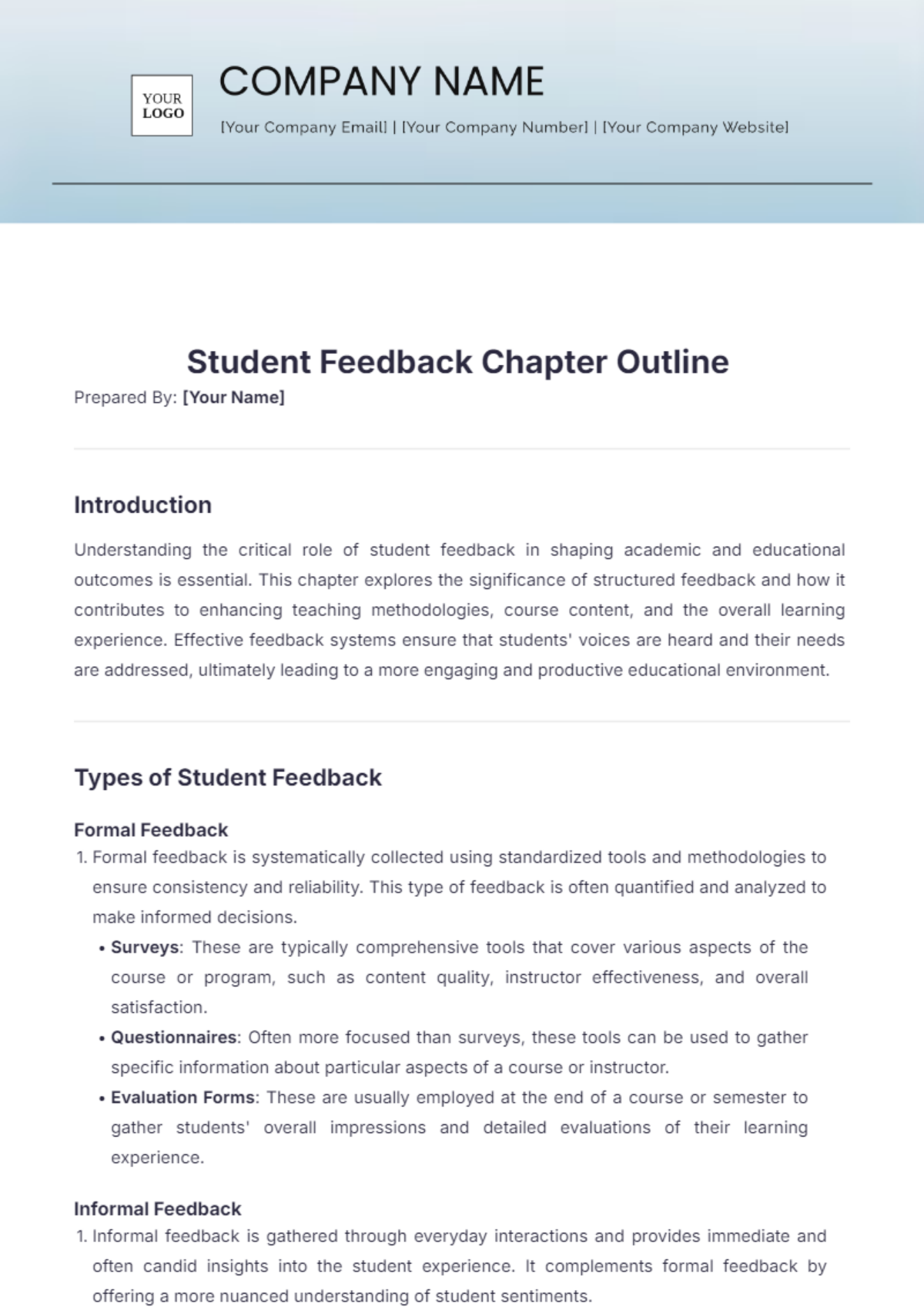
Prepared By: [Your Name]
Introduction
Understanding the critical role of student feedback in shaping academic and educational outcomes is essential. This chapter explores the significance of structured feedback and how it contributes to enhancing teaching methodologies, course content, and the overall learning experience. Effective feedback systems ensure that students' voices are heard and their needs are addressed, ultimately leading to a more engaging and productive educational environment.
Types of Student Feedback
Formal Feedback
Formal feedback is systematically collected using standardized tools and methodologies to ensure consistency and reliability. This type of feedback is often quantified and analyzed to make informed decisions.
Surveys: These are typically comprehensive tools that cover various aspects of the course or program, such as content quality, instructor effectiveness, and overall satisfaction.
Questionnaires: Often more focused than surveys, these tools can be used to gather specific information about particular aspects of a course or instructor.
Evaluation Forms: These are usually employed at the end of a course or semester to gather students' overall impressions and detailed evaluations of their learning experience.
Informal Feedback
Informal feedback is gathered through everyday interactions and provides immediate and often candid insights into the student experience. It complements formal feedback by offering a more nuanced understanding of student sentiments.
Class Discussions: Feedback gained through open dialogue during classes where students can express their views spontaneously.
One-on-One Interactions: Personal conversations between students and instructors or administrators that provide deeper insights into individual experiences and concerns.
Impromptu Comments: Unplanned remarks made by students in various settings that can offer valuable immediate feedback on specific issues.
The Process of Collecting Student Feedback
Preliminary Planning
Objectives: Define the primary goals for collecting feedback, such as improving course content, enhancing instructional methods, or increasing student satisfaction.
Methods: Decide on the appropriate methods for collecting feedback based on the objectives, available resources, and the nature of the feedback sought.
Feedback Collection Methods
Online Surveys: Utilize digital platforms to distribute surveys to a wide audience, ensuring ease of access and increased response rates.
Paper-based Questionnaires: Traditional method suitable for in-class distribution, ensuring that all students have the opportunity to participate.
Focus Groups: Small group discussions facilitated by a moderator to delve deeper into specific topics and gather detailed qualitative feedback.
One-on-One Interviews: Personal interviews that allow for an in-depth exploration of individual student experiences and perspectives.
Implementation
Execute the planned activities to gather feedback, ensuring all students are aware of and understand the importance of their participation.
Data Entry and Analysis
Compile the collected feedback into a structured format, using digital tools for efficient data management and analysis.
Analyzing Student Feedback
Qualitative Analysis
Examine narrative data to identify common themes, patterns, and sentiments. This analysis helps in understanding the underlying reasons behind students' opinions and experiences.
Quantitative Analysis
Use statistical methods to analyze numerical data, such as survey responses. This analysis provides measurable insights and trends that can inform decision-making.
Implementing Changes Based on Feedback
Action Planning
Develop a detailed plan to address areas of improvement identified through feedback. This plan should include specific actions, responsible parties, and timelines.
Execution of Action Plan
Implement the planned changes and monitor their effectiveness through continuous feedback and assessment.
Communication and Closing the Feedback Loop
Providing Feedback to Students: Share the outcomes of the feedback analysis and the actions taken with the student body to demonstrate responsiveness and transparency.
Continuous Improvement: Regularly update practices and strategies to ensure ongoing improvements based on new feedback.
Challenges in Collecting and Utilizing Student Feedback
Engagement
Encourage students to actively participate in feedback processes through awareness campaigns, incentives, and emphasizing the impact of their feedback.
Anonymity
Ensure that student feedback remains anonymous to promote openness and honesty, using secure and confidential collection methods.
Bias
Minimize bias in feedback collection and analysis by using neutral language in surveys, training facilitators, and employing diverse feedback collection methods.
Best Practices for Effective Student Feedback
Clear Objectives
Have well-defined goals for collecting feedback to ensure that the process is focused and meaningful.
Flexibility in Methods
Use a variety of feedback collection methods to accommodate different student preferences and ensure comprehensive data collection.
Regular Follow-ups
Maintain a consistent schedule for collecting and acting on student feedback, ensuring that it becomes an integral part of the educational process.
- 100% Customizable, free editor
- Access 1 Million+ Templates, photo’s & graphics
- Download or share as a template
- Click and replace photos, graphics, text, backgrounds
- Resize, crop, AI write & more
- Access advanced editor
Improve feedback mechanisms with Template.net's Student Feedback Chapter Outline Template. This editable and customizable tool simplifies the process of collecting and organizing student feedback. Editable in our Ai Editor Tool for your convenience.

